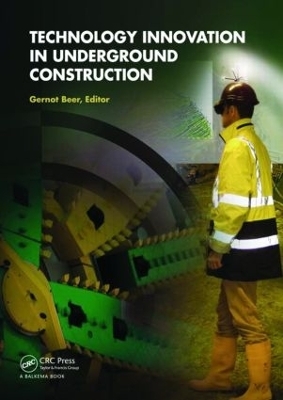
Technology Innovation in Underground Construction
CRC Press (Verlag)
978-0-415-55105-2 (ISBN)
This richly-illustrated reference guide presents innovative techniques focused on reducing time, cost and risk in the construction and maintenance of underground facilities:
A primary focus of the technological development in underground engineering is to ease the practical execution and to reduce time, cost and risk in the construction and maintenance of underground facilities such as tunnels and caverns. This can be realized by new design tools for designers, by instant data access for engineers, by virtual prototyping and training for manufacturers, and by robotic devices for maintenance and repair for operators and many more advances.
This volume presents the latest technological innovations in underground design, construction, and operation, and comprehensively discusses developments in ground improvement, simulation, process integration, safety, monitoring, environmental impact, equipment, boring and cutting, personnel training, materials, robotics and more. These new features are the result of a big research project on underground engineering, which has involved many players in the discipline.
Written in an accessible style and with a focus on applied engineering, this book is aimed at a readership of engineers, consultants, contractors, operators, researchers, manufacturers, suppliers and clients in the underground engineering business. It may moreover be used as educational material for advanced courses in tunnelling and underground construction.
Short professional biographies of all contributors are included in the back of the volume. The editor, Gernot Beer (Graz University of Technology, Austria), is currently the head of the Institute for Structural Analysis at the University Technology, Graz Austria. His main expertise is numerical simulation and he heads a group of researchers that is developing the next generation software for the simulation of underground excavations. He has conducted research and has consulted on this topic for three decades and authored and co-authored four textbooks on this subject. Prior to coordinating the project TUNCONSTRUCT he was the coordinator of a national research initiative Simulation in Tunneling (SiTu) and of another European project (Virtual fire emergency simulation, VITRUALFIRES). The project SiTu resulted in a book “Numerical Simulation in Tunneling” published by Springer for which he was the editor. As part of his consulting activities he served, together with Prof. E.T. Brown, on a panel of experts for the investigation of the Masjed-e-Soleiman underground Hydroelectric Power Plant in Iran.
1. Introduction 2. UCIS – Underground Construction Information System 3. Computer-support for the Design of Underground Structures 4. A Virtual Reality Visualization System for Underground Construction 5. From Laboratory, Geological and TBM Data to Input Parameters for Simulation Models 6. Process-oriented Numerical Simulation of Mechanized Tunneling 7. Computer Simulation of Conventional Construction 8. Optical Fibre Sensing Cable for Underground Settlement Monitoring During Tunneling 9. Tunnel Seismic Exploration and Its Validation Based on Data From TBM Control and Observed Geology 10. Advances in the Steering of Tunnel Boring Machines 11. Real-time Geological Mapping of the Front Face 12. Reducing the Environmental Impact of Tunnel Boring (OSCAR) 13. Safety Assessment During Construction of Shotcrete Tunnel Shells Using Micromechanical Material Models 14. Observed Segment Behaviour During Tunnel Advances 15. Optimizing Rock Cutting Through Computer Simulation 16. Innovative Roadheader Technology for Safe and Economic Tunnelling 17. Tube-à-manchette Installation Using Horizontal Directional Drilling for Soil Grouting 18. TBM Technology for Large to Very Large Tunnel Profiles 19. Real-time Monitoring of the Shotcreting Process 20. Environmentally Friendly, Customised Sprayed Concrete 21. Innovations in Shotcrete Mixes 22. High Performance and Ultra High Performance Concrete Segments – Development and Testing 23. Robotic Tunnel Inspection and Repair 24. An Innovative Geotechnical Characterization Method for Deep Exploration.
| Erscheint lt. Verlag | 16.10.2009 |
|---|---|
| Verlagsort | London |
| Sprache | englisch |
| Maße | 174 x 246 mm |
| Gewicht | 1020 g |
| Themenwelt | Naturwissenschaften ► Biologie ► Ökologie / Naturschutz |
| Technik ► Bauwesen | |
| Technik ► Bergbau | |
| Technik ► Umwelttechnik / Biotechnologie | |
| ISBN-10 | 0-415-55105-6 / 0415551056 |
| ISBN-13 | 978-0-415-55105-2 / 9780415551052 |
| Zustand | Neuware |
| Haben Sie eine Frage zum Produkt? |
aus dem Bereich


